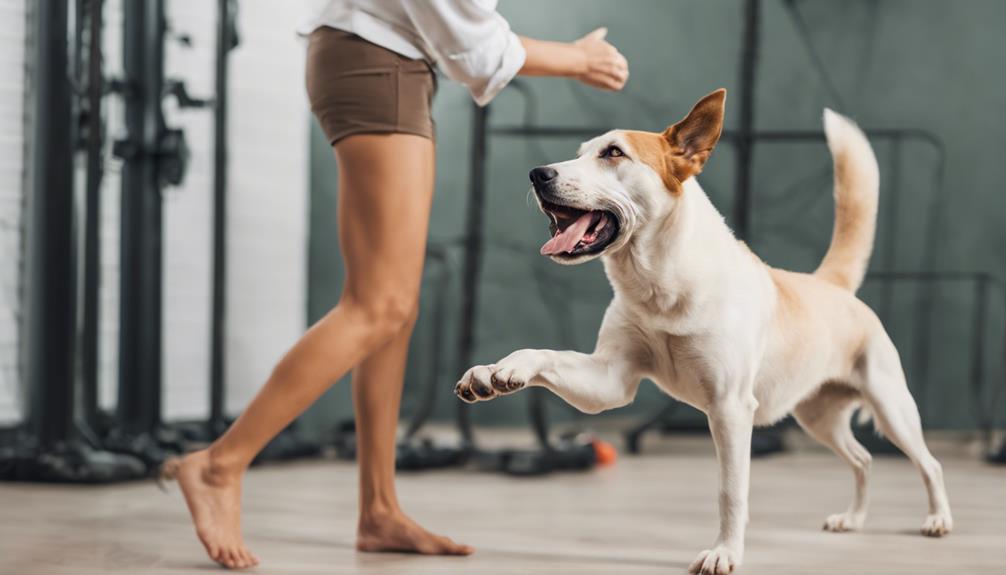What Does Training Do to Dog Communication?
Did you know that a study found that trained dogs were able to correctly interpret human pointing gestures 95% of the time?
Training doesn't just teach your dog commands; it can significantly impact how they communicate with you and others.
From body language cues to verbal signals, the effects of training on dog communication are vast and fascinating.
By exploring the intricacies of this topic, you'll gain a deeper understanding of the profound effects training can have on your furry friend's ability to interact effectively with the world around them.
Improved Understanding of Commands
To ensure effective communication with your dog, use consistent hand signals along with verbal commands for improved understanding. Incorporating hand signals into your training routine can significantly enhance your dog's comprehension of commands. Effective obedience training involves consistent repetition of both verbal cues and corresponding hand signals. By pairing these signals together, you can create a strong association between the command and the desired behavior, leading to increased responsiveness to commands.
Consistency is key when implementing hand signals during training sessions. Make sure to use the same gestures each time you give a command to avoid confusion. Dogs thrive on routine and clear expectations, so maintaining a steady approach will help them grasp the commands more effectively. Additionally, using hand signals can bridge any language barriers between you and your dog, as they rely heavily on visual cues in their communication.
Enhanced Body Language Recognition
Enhance your dog training skills by honing your ability to recognize their body language cues accurately. Understanding your dog's nonverbal cues is crucial for effective communication and behavior interpretation. Dogs communicate primarily through body language, using signals like ear position, tail wagging, and overall posture to convey their feelings and intentions.
By paying close attention to these cues, you can better understand what your dog is trying to communicate, leading to improved training outcomes.
Learning to interpret your dog's behavior accurately allows you to respond appropriately to their needs and emotions. For example, a tucked tail or flattened ears may indicate fear or anxiety, while a relaxed body posture and wagging tail typically signal happiness and friendliness.
Clearer Verbal Communication Signals
Improve your dog training effectiveness by incorporating clearer verbal communication signals to complement your understanding of their body language cues.
While dogs rely heavily on non-verbal cues and visual signals to navigate their world, integrating precise verbal commands can enhance your communication with them.
When training your dog, use consistent and simple verbal cues that directly correspond to the desired behavior. For instance, saying 'sit' when you want your dog to sit reinforces the action they should take.
Clear verbal commands help your dog associate words with actions, making it easier for them to understand what you expect.
Strengthened Bond Between Dog and Owner
Building a strong bond with your dog involves consistent training, positive reinforcement, and mutual understanding. Trust building is a crucial aspect of this bond, as your dog learns to rely on you for guidance and support.
Through training, you not only teach commands but also develop cooperation skills that enhance your communication and relationship. By working together, you reinforce the bond between you and your furry companion.
Mutual understanding deepens as you learn to interpret your dog's cues and body language more effectively, strengthening your connection. Spending quality time training and engaging with your dog not only improves obedience but also fosters a sense of teamwork and companionship.
Reduced Misinterpretation of Cues
To minimize confusion and enhance communication with your dog, focus on accurately interpreting their cues and body language. Understanding your dog's nonverbal signals is crucial for effective communication. Here are four key points to help you reduce misinterpretation of cues:
- Observe Body Language Cues: Pay attention to your dog's posture, tail position, ear movements, and facial expressions. These cues can provide valuable insights into their emotions and intentions.
- Learn Nonverbal Signals: Dogs communicate through a variety of nonverbal signals such as eye contact, yawning, licking their lips, or wagging their tail. Familiarize yourself with these signals to better understand your furry companion.
- Practice Active Listening: Engage with your dog by actively listening to their vocalizations and observing their body language. This two-way communication can help build a stronger bond and reduce misunderstandings.
- Seek Professional Guidance: If you struggle to interpret your dog's cues accurately, consider seeking guidance from a professional dog trainer or behaviorist. They can provide valuable insights and help improve your communication skills with your canine friend.
Increased Confidence in Dog's Response
To strengthen your confidence in your dog's response, focus on consistent reinforcement of desired behaviors through clear communication and positive reinforcement techniques. Behavior modification and obedience training play crucial roles in enhancing your dog's responsiveness. By consistently rewarding the behaviors you want to encourage, you're reinforcing the connection between the action and the positive outcome. This not only helps your dog understand what's expected but also boosts their confidence in responding correctly.
Understanding canine psychology and behavior modification is key to building this confidence. Dogs thrive on routine and clear expectations. By establishing a structured training regimen that incorporates positive reinforcement, you're providing your dog with the tools they need to succeed. This predictability and positive feedback build their confidence in their ability to meet your expectations.
As you continue to work on obedience training and behavior modification, remember that patience and consistency are essential. Celebrate small victories and remain positive throughout the training process. Your dog's increased confidence in their responses is a reflection of your dedication to their training and well-being.
Enhanced Social Interaction Skills

Fostering your dog's social interaction skills involves encouraging positive encounters with other dogs and humans through controlled exposure and reinforcement. This process helps your furry friend develop crucial abilities that enhance their communication skills and overall well-being.
Here are four key aspects to consider when enhancing your dog's social interaction skills:
- Canine Play Behavior: Understanding how your dog engages in play with other dogs can provide insights into their social preferences and help you facilitate positive social interactions.
- Social Cues: Teaching your dog to recognize and respond to social cues from other dogs and humans can improve their ability to communicate effectively in various social settings.
- Positive Reinforcement: Rewarding desirable social behaviors can reinforce your dog's inclination to engage in positive interactions, fostering a friendly and sociable demeanor.
- Consistent Training: Regular practice and exposure to different social situations can help your dog feel more comfortable and confident when interacting with others, ultimately enhancing their social skills.
Improved Problem-Solving Abilities
Enhancing your dog's problem-solving abilities can be achieved through engaging activities that challenge their cognitive skills and encourage independent thinking. By providing cognitive stimulation and incorporating problem-solving exercises into your dog's routine, you can promote mental enrichment and skill development.
Introducing interactive toys that require your dog to figure out how to access treats or toys can be a fun way to enhance their problem-solving skills. Puzzle feeders, where your dog needs to manipulate levers or move pieces to release food, are excellent for engaging their cognitive abilities. Additionally, hiding treats around the house or yard for your dog to find can encourage them to use their sense of smell and observational skills to solve the 'puzzle.'
Engaging in activities that promote problem-solving not only provides mental enrichment but also strengthens the bond between you and your furry friend. Through consistent engagement in such exercises, your dog can develop a sharper mind and improved problem-solving abilities.
Frequently Asked Questions
How Long Does It Typically Take for a Dog to Show Improvement in Communication Skills After Training?
Improvement in your dog's communication skills after training can vary depending on factors like consistency and the specific training methods used. Some dogs may show progress in a few weeks, while others might take longer.
The duration of training and the effectiveness of the methods employed play a crucial role in how quickly your dog's communication skills improve. Stay patient and consistent to see the best results in your furry friend's progress.
Can Training Help With Addressing Specific Behavioral Issues in Dogs, Such as Aggression or Anxiety?
Training can definitely help with addressing specific behavioral issues in dogs, such as aggression or anxiety. Through positive reinforcement and consistency, you can effectively modify your dog's behavior.
Seeking professional guidance and ensuring proper socialization are key components of successful training. By working with your dog consistently and using positive reinforcement techniques, you can make significant progress in addressing these behavioral issues.
Are There Specific Training Techniques That Are More Effective for Improving Communication Between Dogs and Their Owners?
When improving communication between dogs and their owners, focus on positive reinforcement and body language cues. Reward desired behaviors to strengthen the bond and understanding.
Use clear signals like hand gestures and facial expressions to convey your intentions effectively. Consistent training with these techniques can enhance the connection and mutual understanding between you and your dog, leading to better communication overall.
How Can Training Help With Communication Between Multiple Dogs in a Household?
Training can greatly aid in improving communication among multiple dogs in a household. By teaching them to understand each other's body language, social cues, and vocalizations, you can help them navigate pack dynamics more effectively.
Through consistent training, you can create a harmonious environment where your dogs can communicate and interact positively with one another, leading to a happier and more cohesive pack dynamic.
Are There Any Potential Drawbacks or Challenges Associated With Training That Could Impact Dog Communication?
When it comes to potential drawbacks or challenges with training that could affect dog communication, consistency plays a big role. It's crucial to be consistent with your training methods to avoid confusion.
Balancing rewards is also essential. Rewarding good behavior helps reinforce positive communication, but be careful not to overdo it or your dog might respond poorly.
Keep these factors in mind to maintain effective communication during training.
Conclusion
Overall, training plays a crucial role in enhancing dog communication. It helps improve understanding of commands, recognize body language cues, and strengthen the bond between dog and owner.
Through training, misinterpretation of cues is reduced, confidence in the dog's response is increased, and social interaction skills are enhanced.
Ultimately, training not only benefits the communication between dogs and their owners, but also improves problem-solving abilities and creates a harmonious relationship between them.
